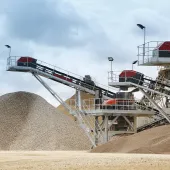Celebrating Tarmac’s biodiversity conservation

Award-winning photographers focus lenses on diverse wildlife inhabiting Tarmac’s quarries
BIODIVERSITY around Tarmac’s quarries is being celebrated by award-winning photographers who have captured the incredible array of wildlife that has made its home in restored and active sites, thanks to the company’s conservation efforts.
Tarmac employees Jeremy West and Ian Rumbellow finished second and third, respectively, in the Mineral Products Association’s 2021 Nature Photo competition showcasing stunning images of animals and insects living in and around restored quarries throughout the UK.
Mr West won second place with his picture of a peregrine falcon and its prey, while Mr Rumbellow picked up third prize for a close-up image of a southern migrant hawker dragonfly, taken at Gallows Hill Quarry, in Suffolk.
The pair’s work is featured in the MPA’s new anniversary publication Quarries & Nature – a 50-year success story. The stunning images in the book have been drawn from hundreds of entries over recent years from employees of quarrying companies and volunteers at restored sites managed by partner organizations, such as the RSPB and Wildlife Trusts.
Mr West, assistant manager at Tarmac’s Swinden Quarry, in Yorkshire, said: ‘It’s fantastic to be recognized for my photography but, even more importantly, it shows just what wondrous wildlife we have in and around our quarries.
‘Our efforts to protect the biodiversity around our quarries is vital in creating the unique habitats in which birds, such as peregrine falcons, and many other species can thrive. We’re lucky that there is such a diverse number of species here; we’re in the foothills of Yorkshire Dales National Park and the Nidderdale Area of Natural Beauty.’
Mr Rumbellow, site manager at Barham Sand and Gravel Quarry, in Suffolk, has been taking pictures throughout the 36 years he has worked there.
‘Barham is surrounded by water and trees and is quite overgrown around the periphery so you wouldn’t know there is a quarry here,’ he explained. ‘We are well hidden from the outside world but that means there is plenty of wildlife to take pictures of. We’re very fortunate because some of them are protected species.’
Publication of the Quarries & Nature brochure follows the premiere of a special 50th anniversary documentary film which celebrates the vast and unique contribution of restored quarries to UK nature over the past 50 years. In the film, leading conservationists from Natural England, RSPB, The Wildlife Trusts and other organizations recognize quarrying’s critical role in nature recovery in the past half-century.
Mark Russell, executive director of the MPA, said: ‘The vital role quarries play in nature conservation is one of the industry’s best kept secrets. Maybe that’s because by the time a well-restored quarry scheme has come to fruition, most people have forgotten that the site once provided the essential materials for the places where they live, work and play.
‘In England alone there are over 2,000 quarries, covering 64,000 hectares (0.1% of the country's land area) all of which will eventually be restored. Through careful planning, imaginative design and innovative engineering, each site is an opportunity to create a new landscape where rare and endangered species can thrive.’









